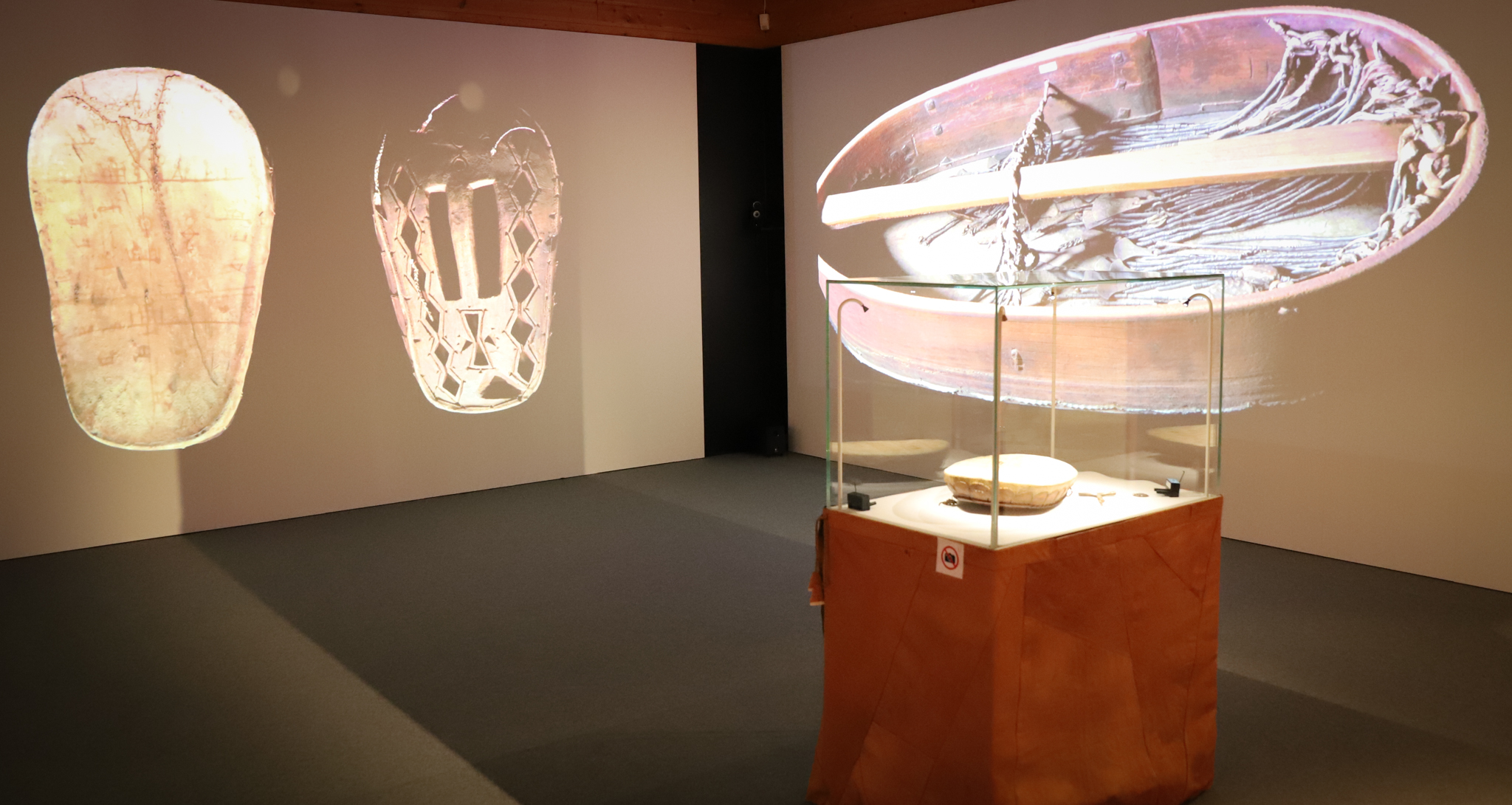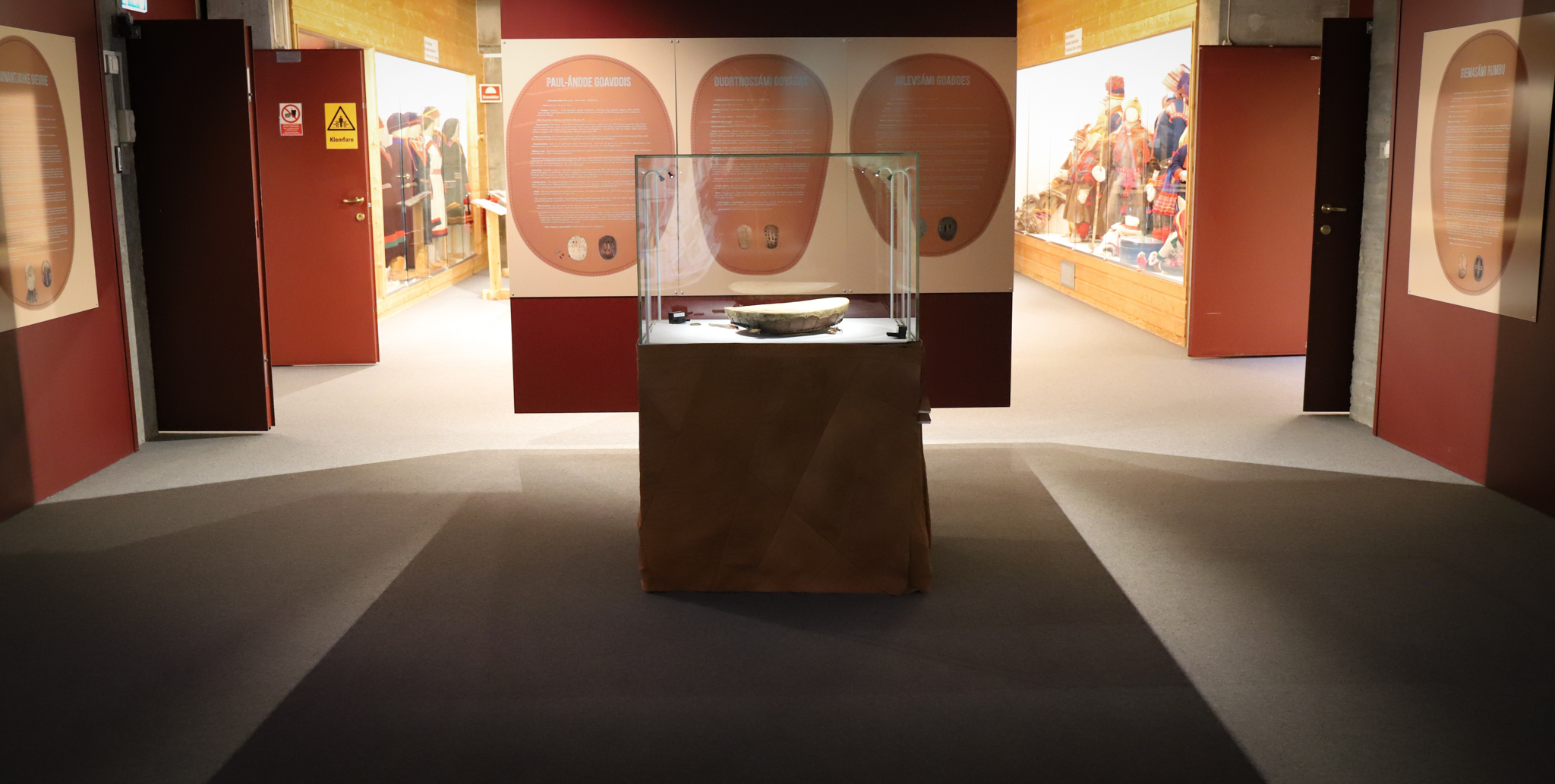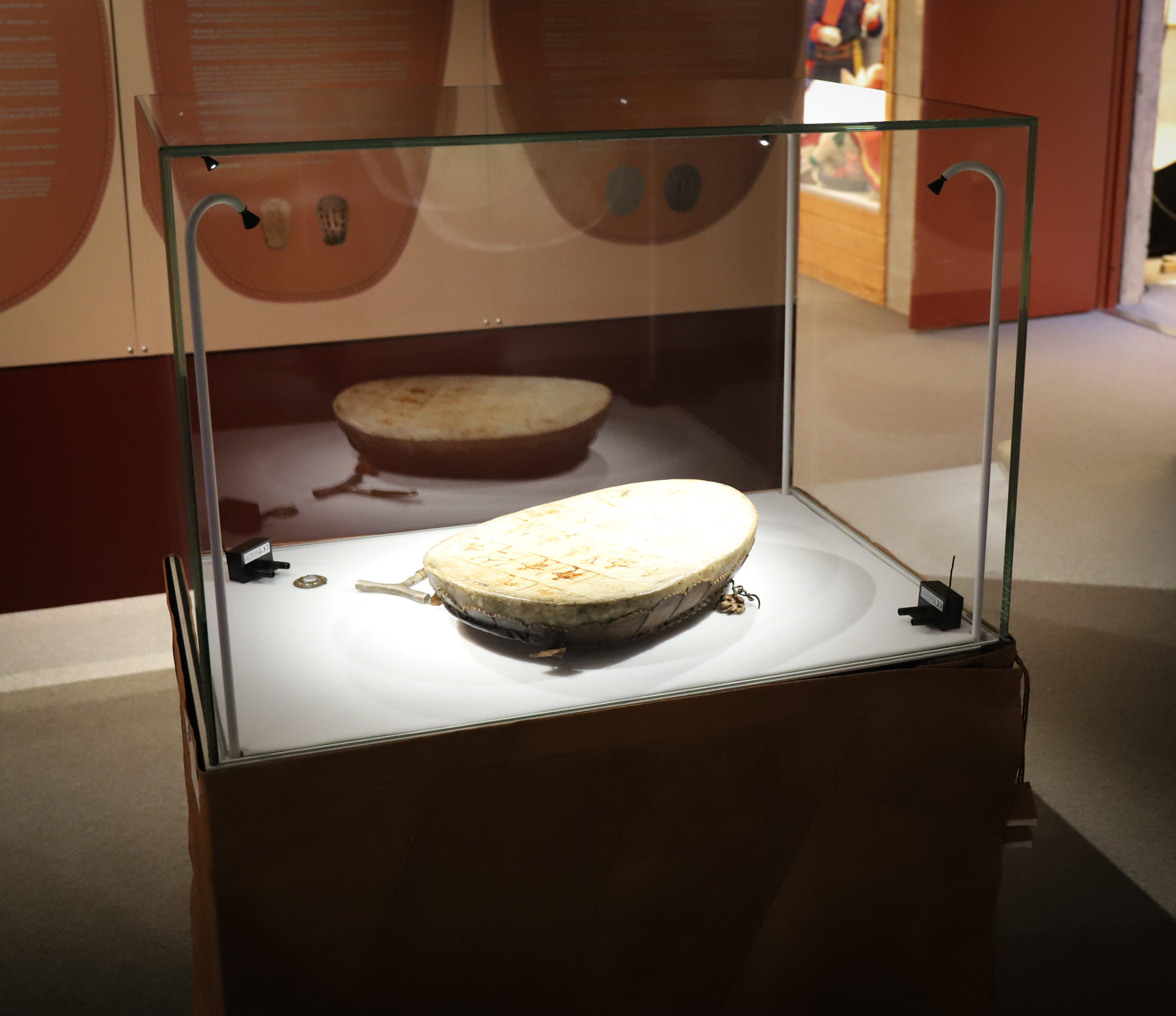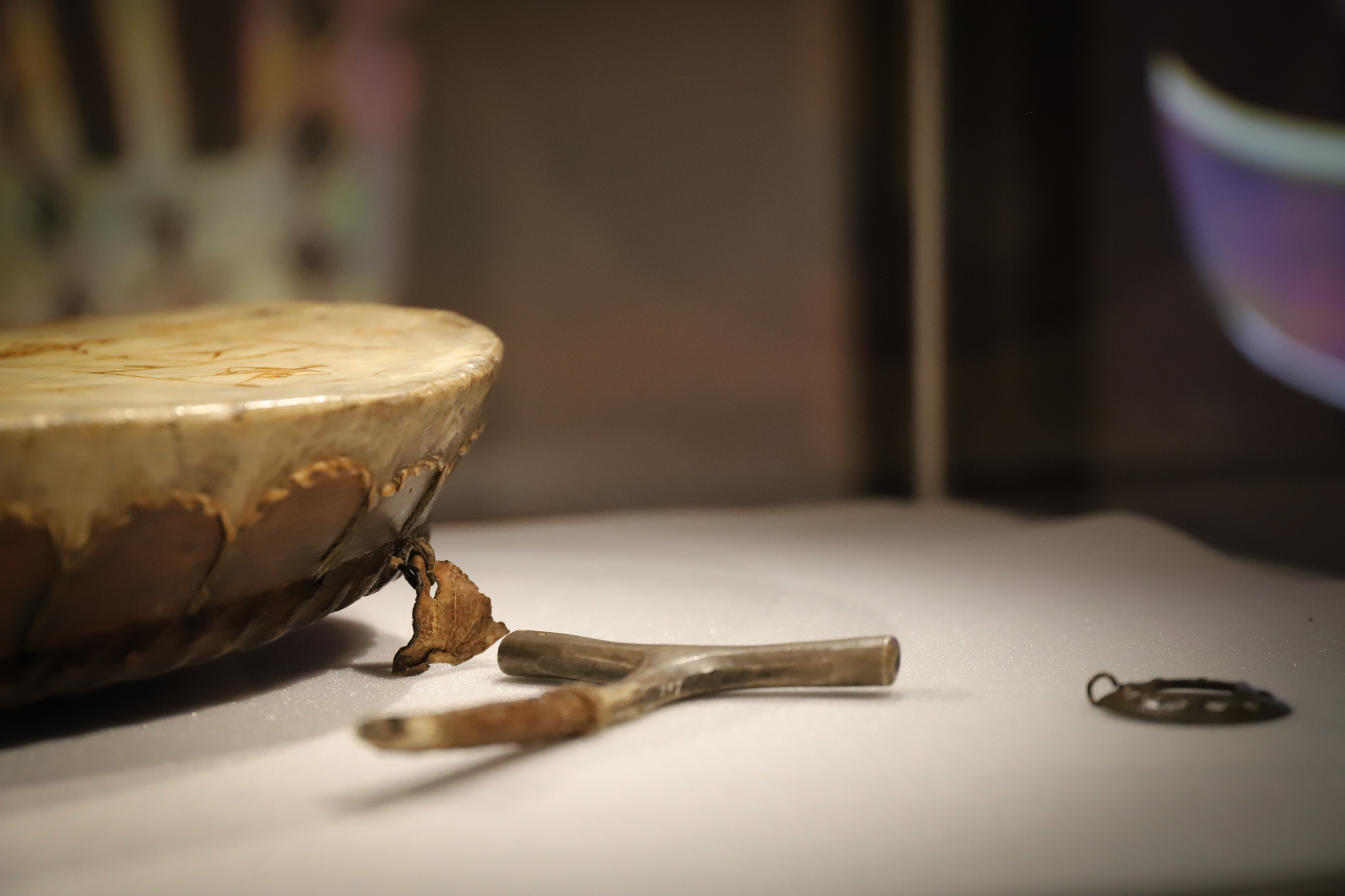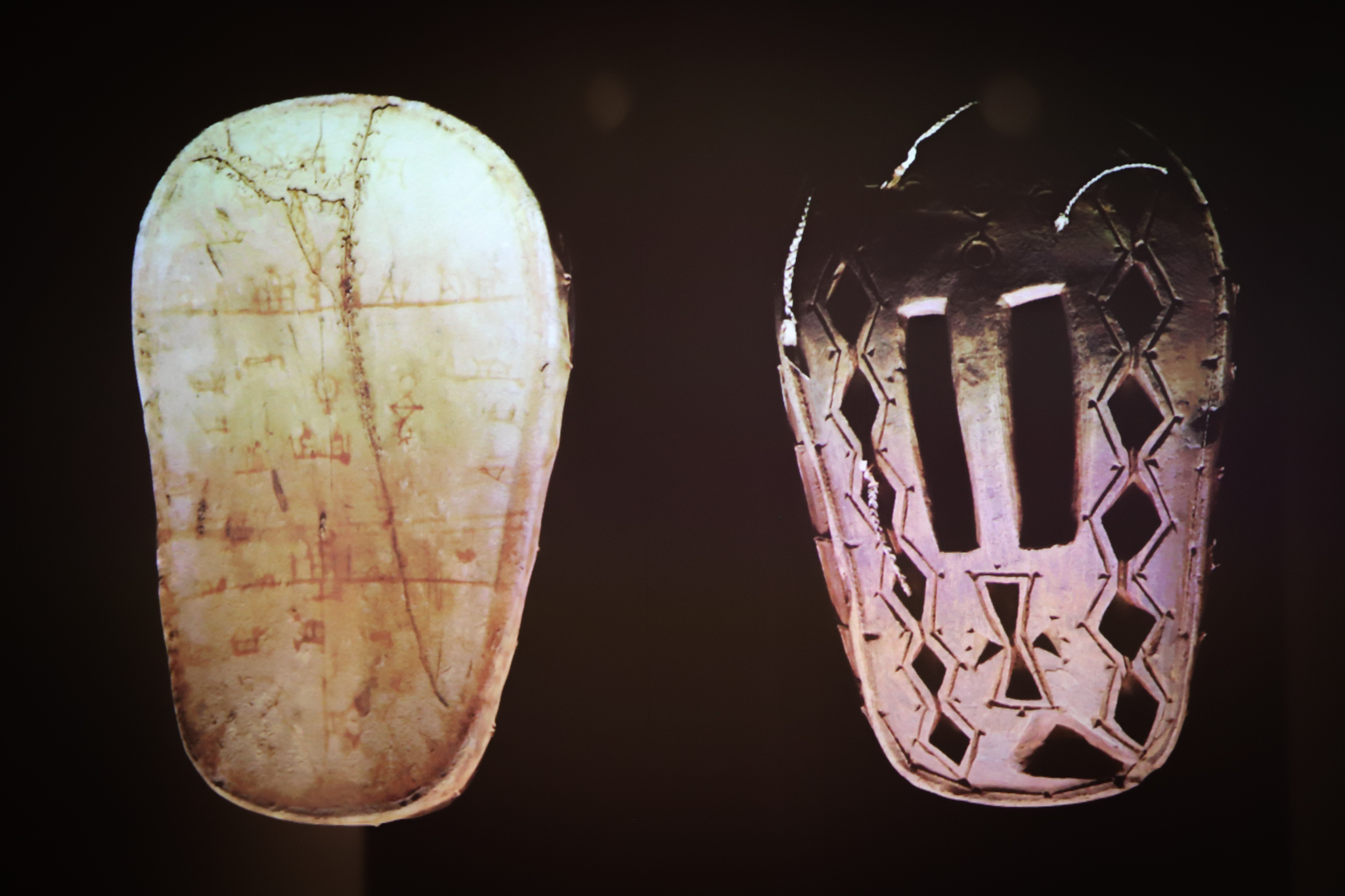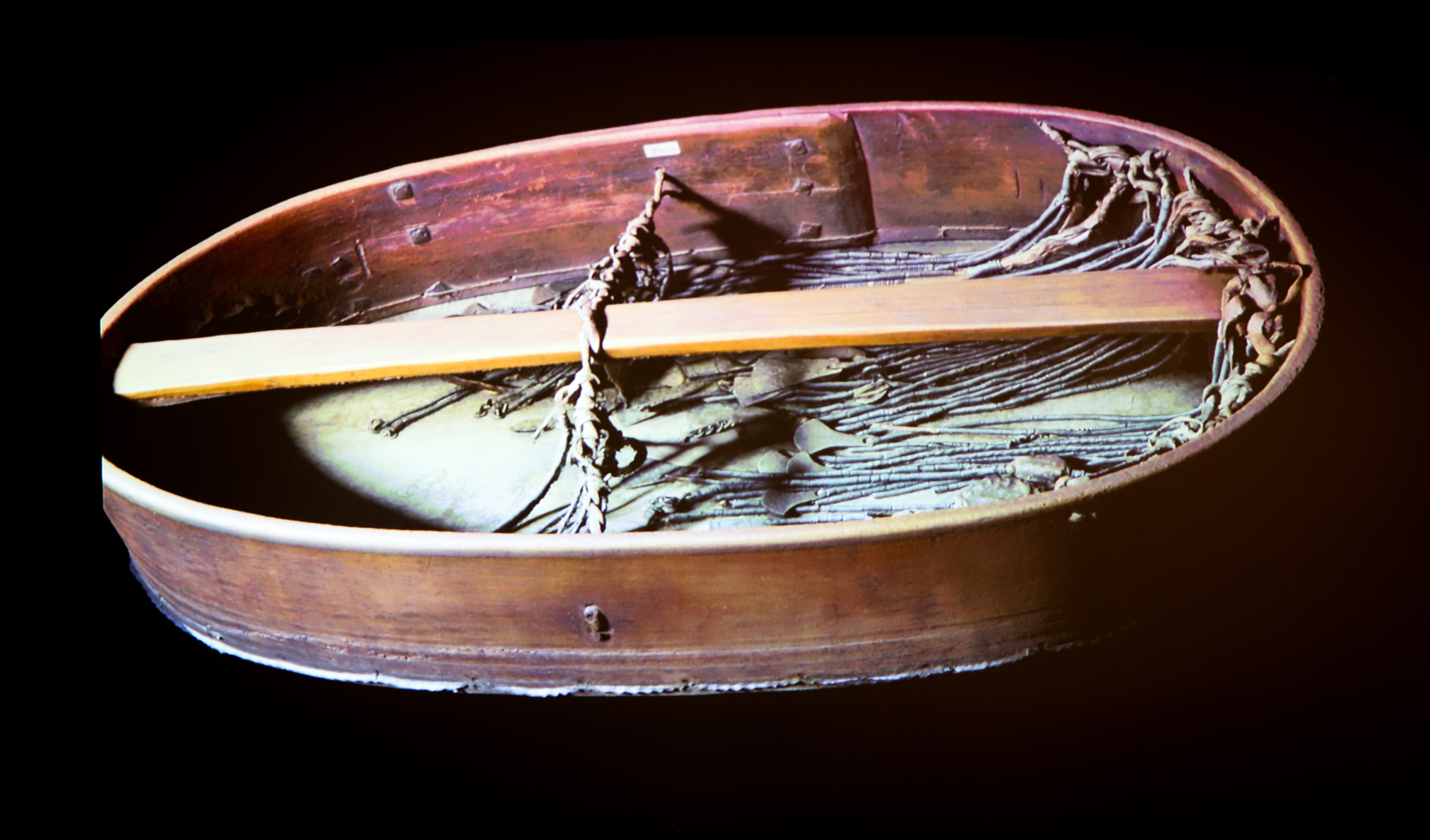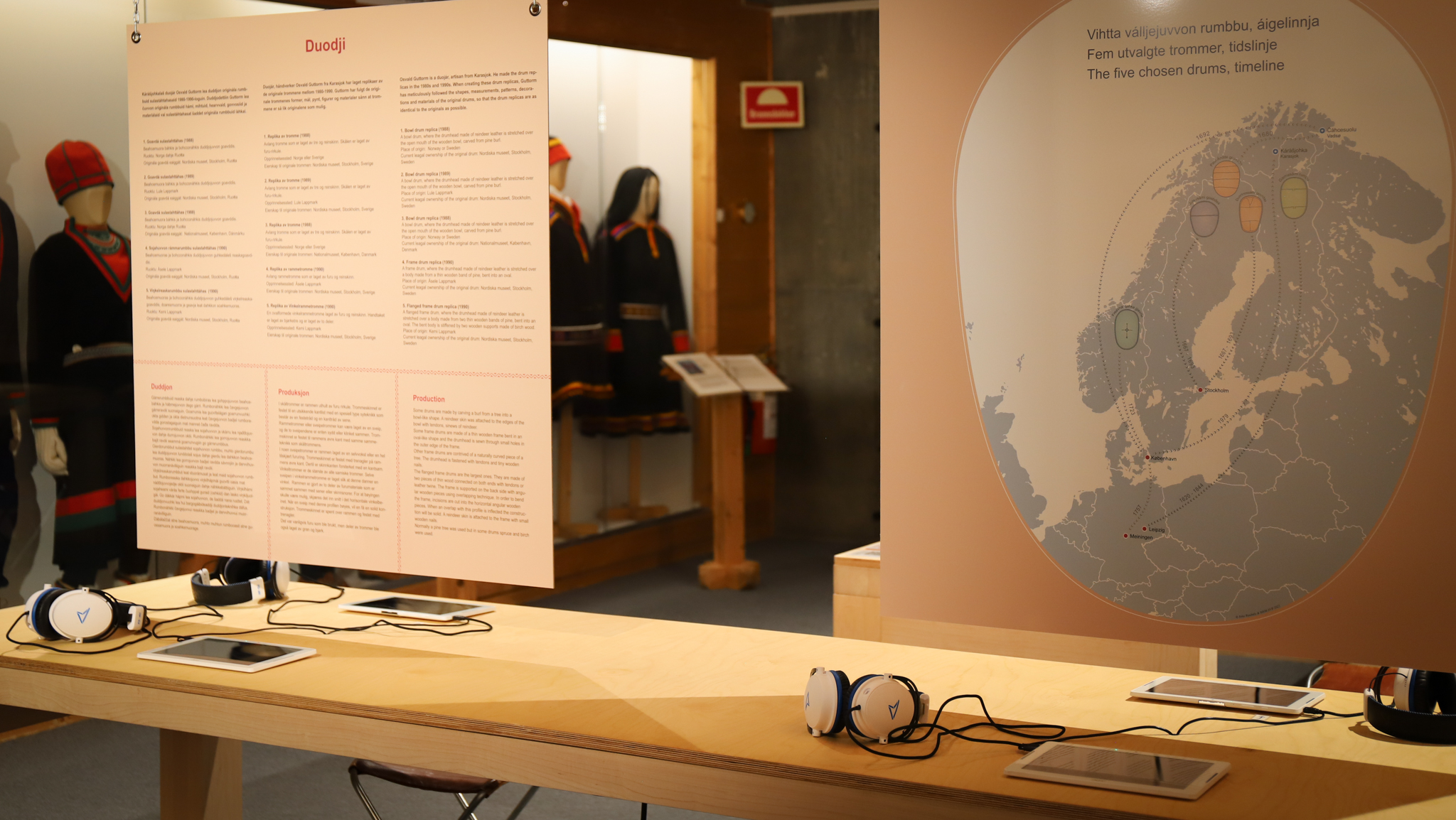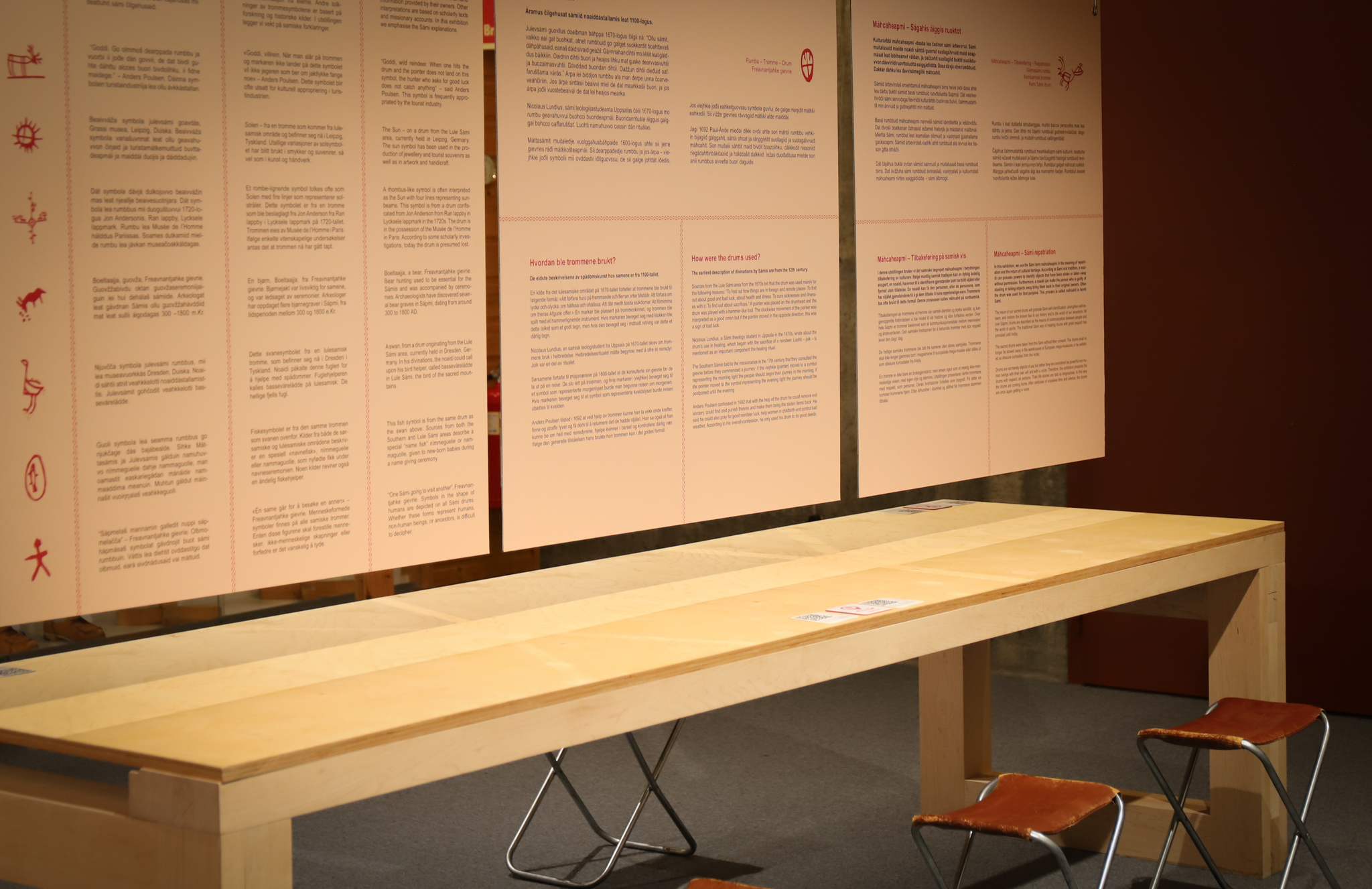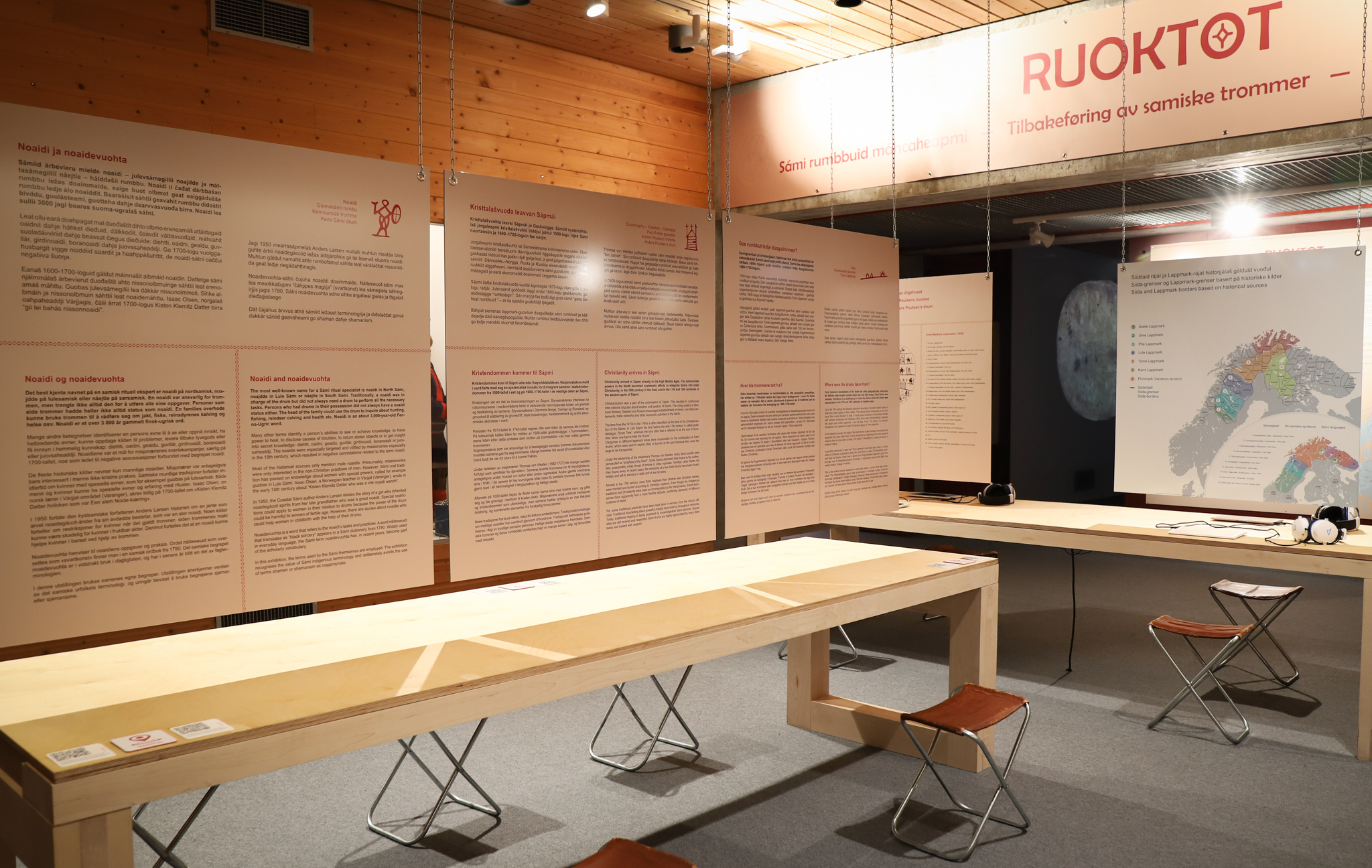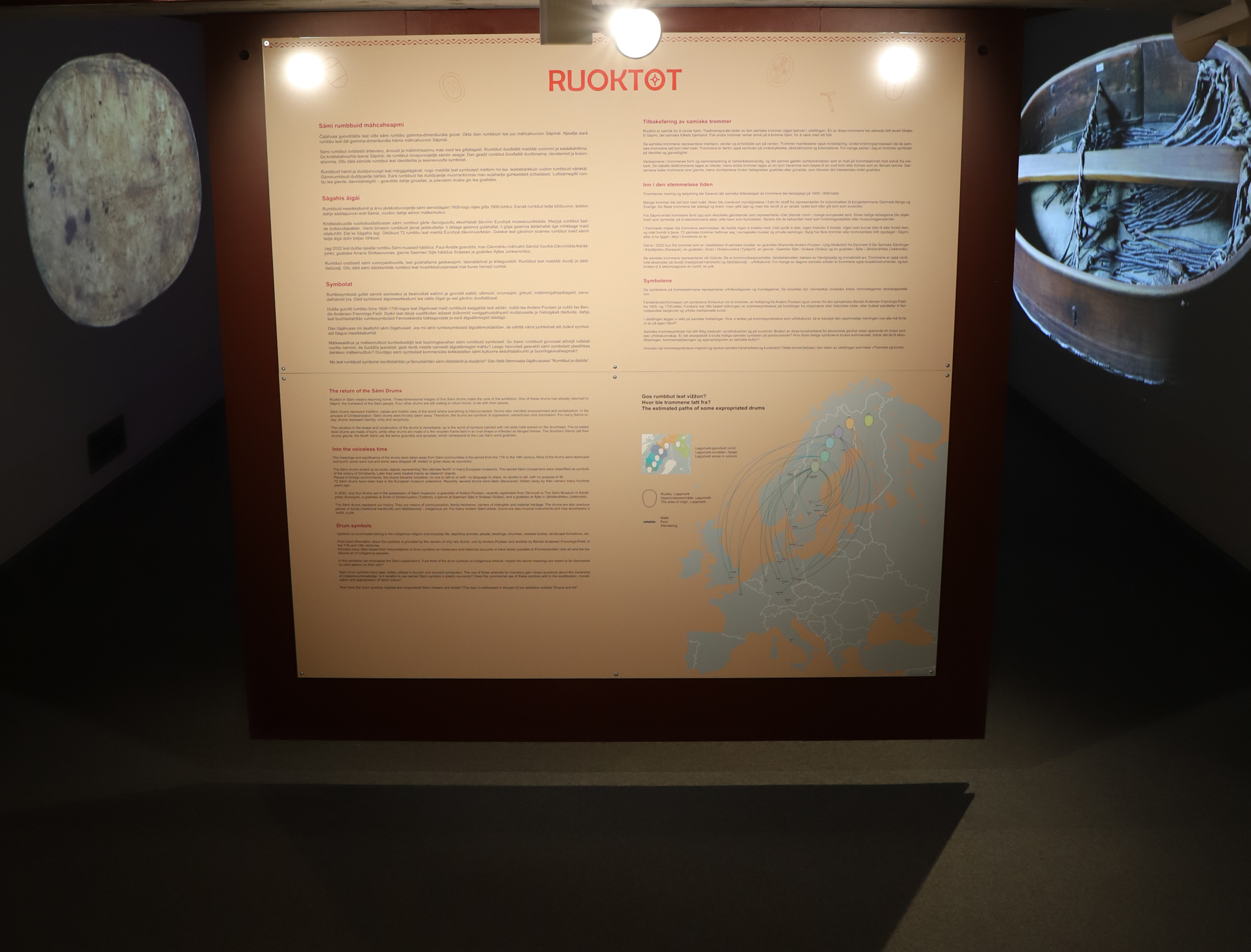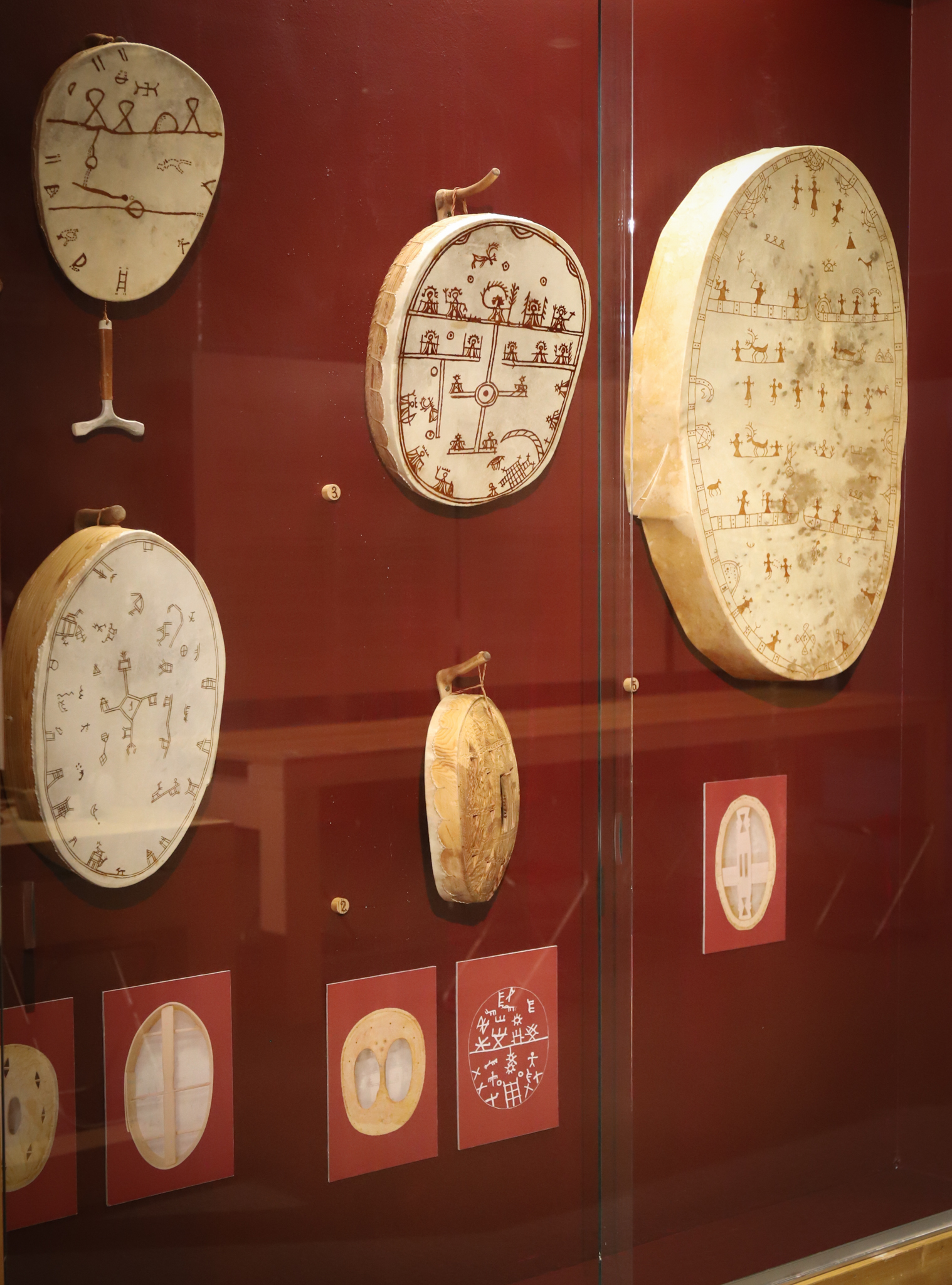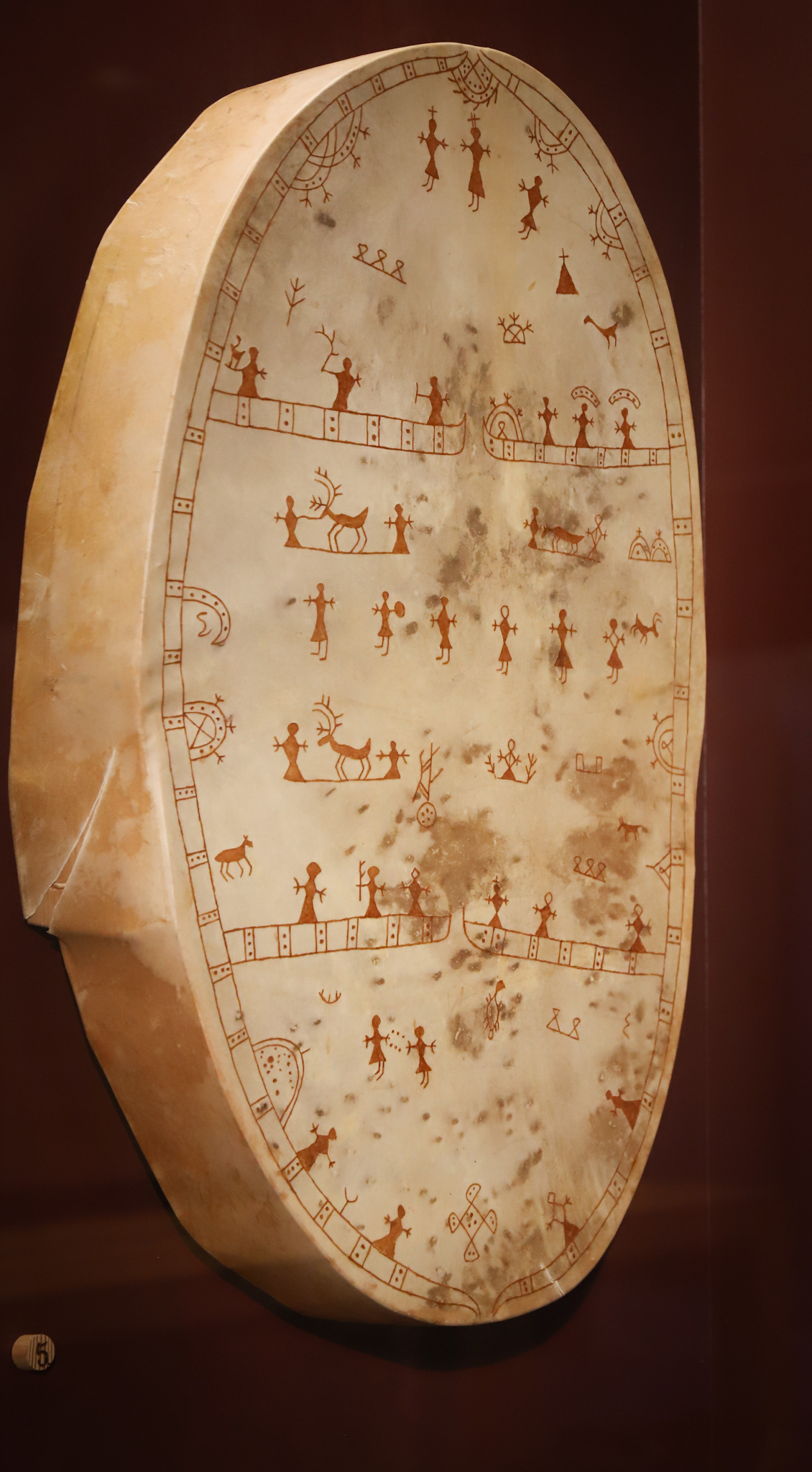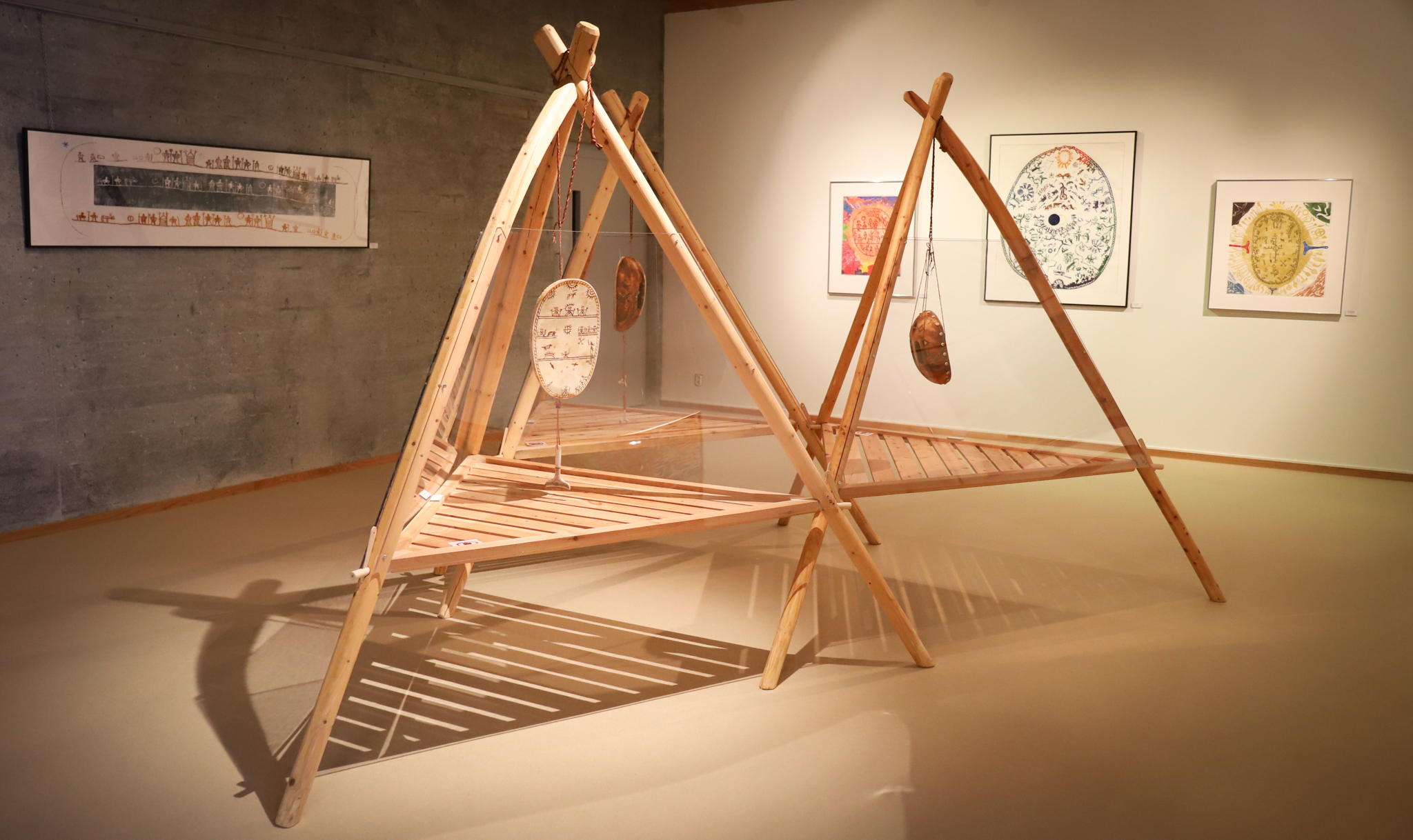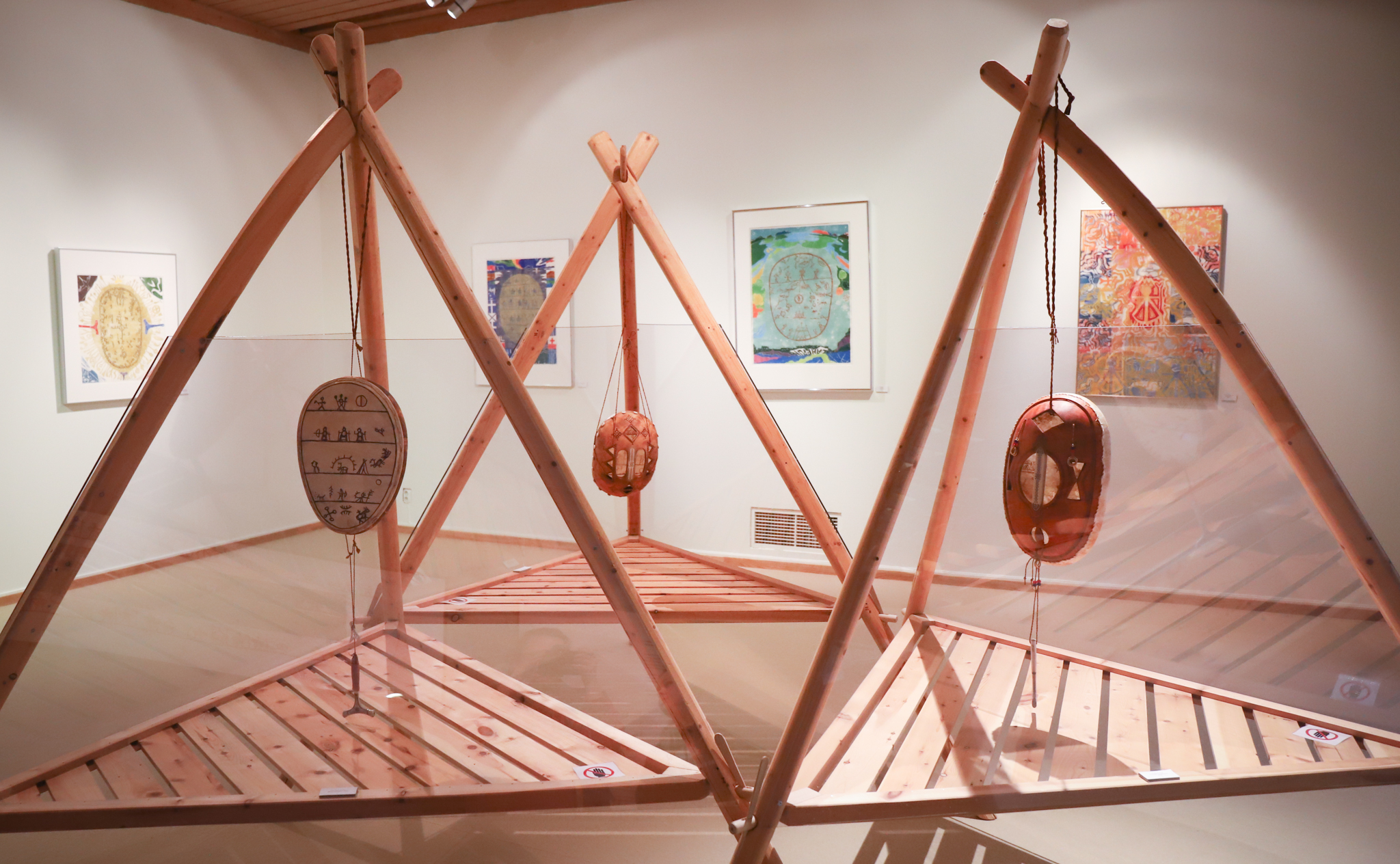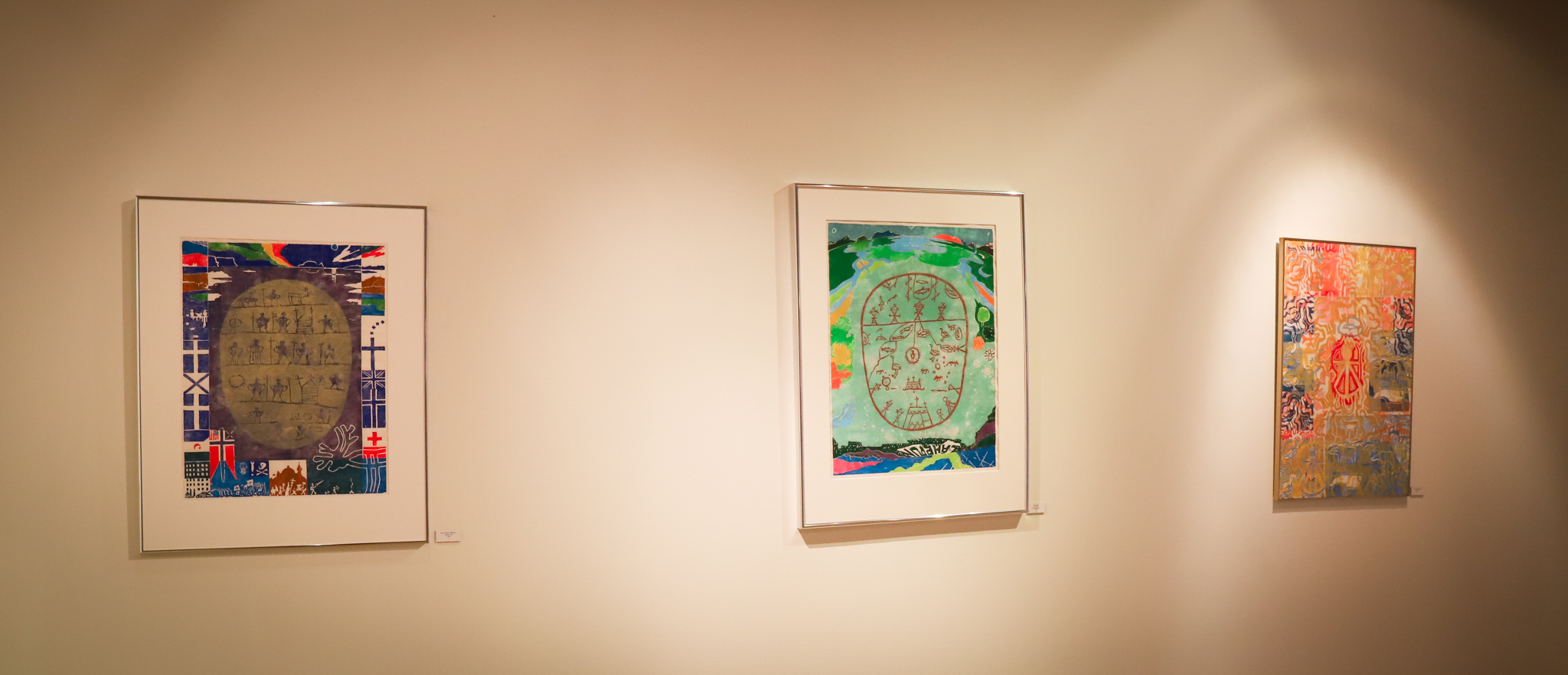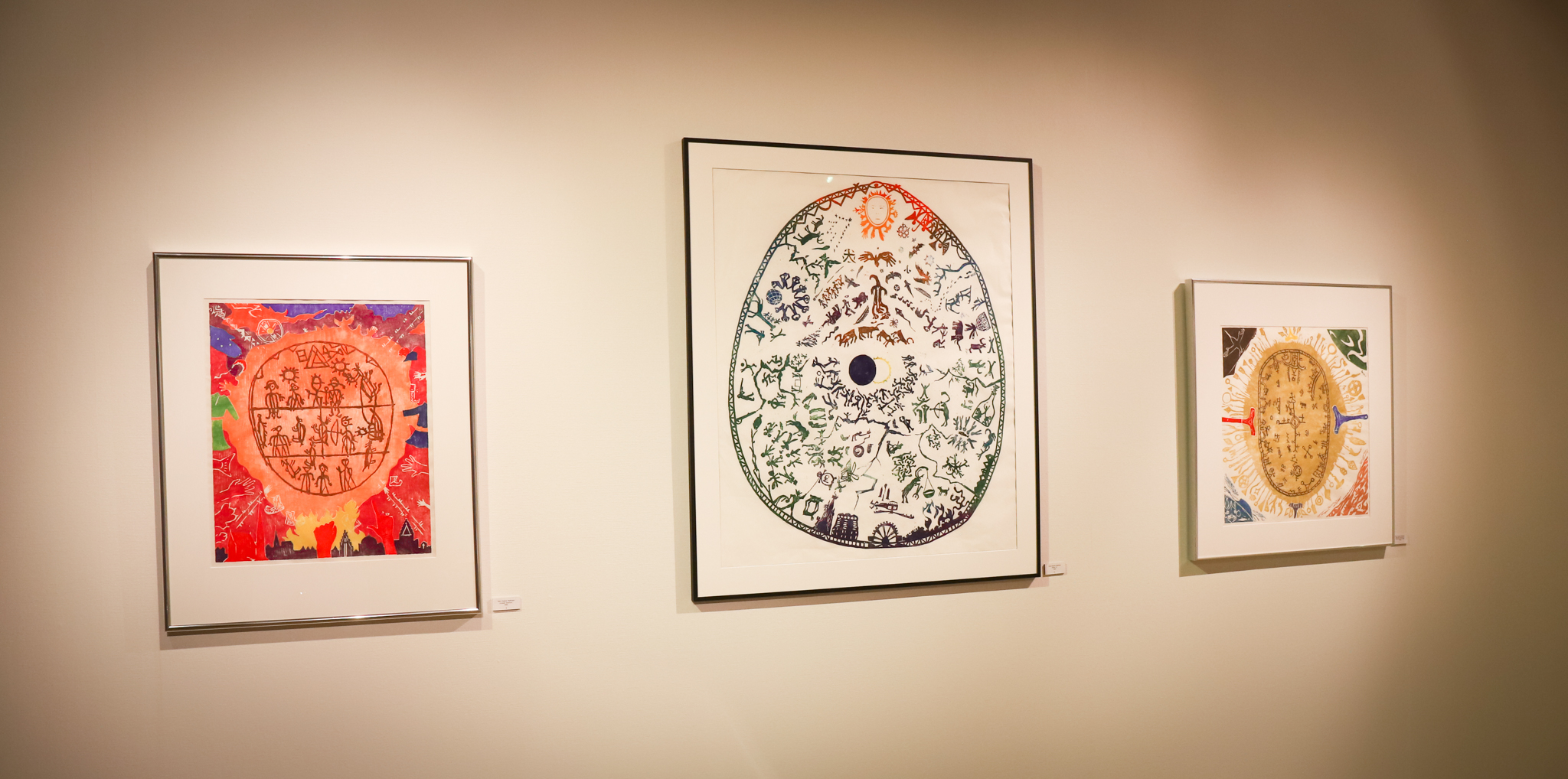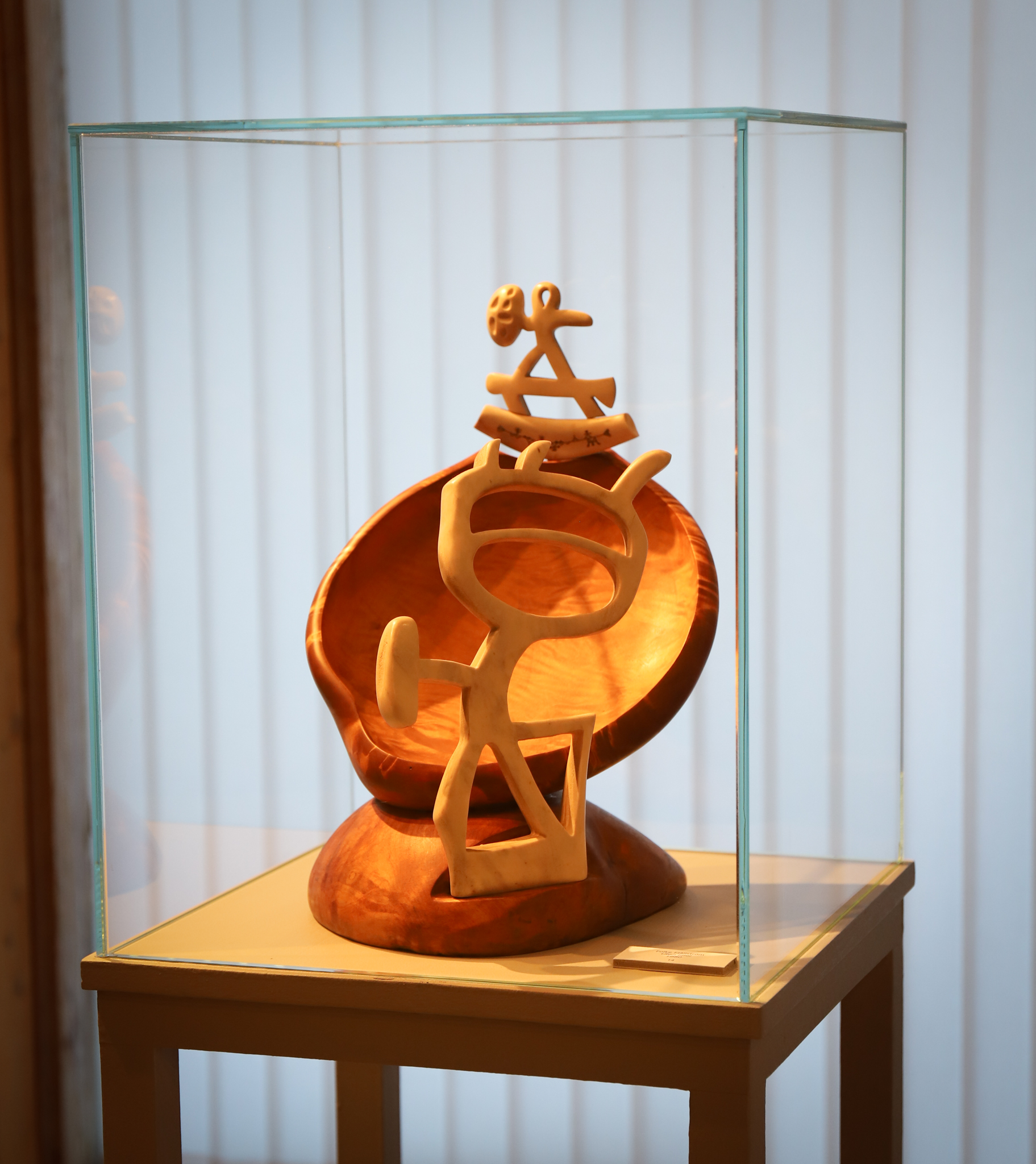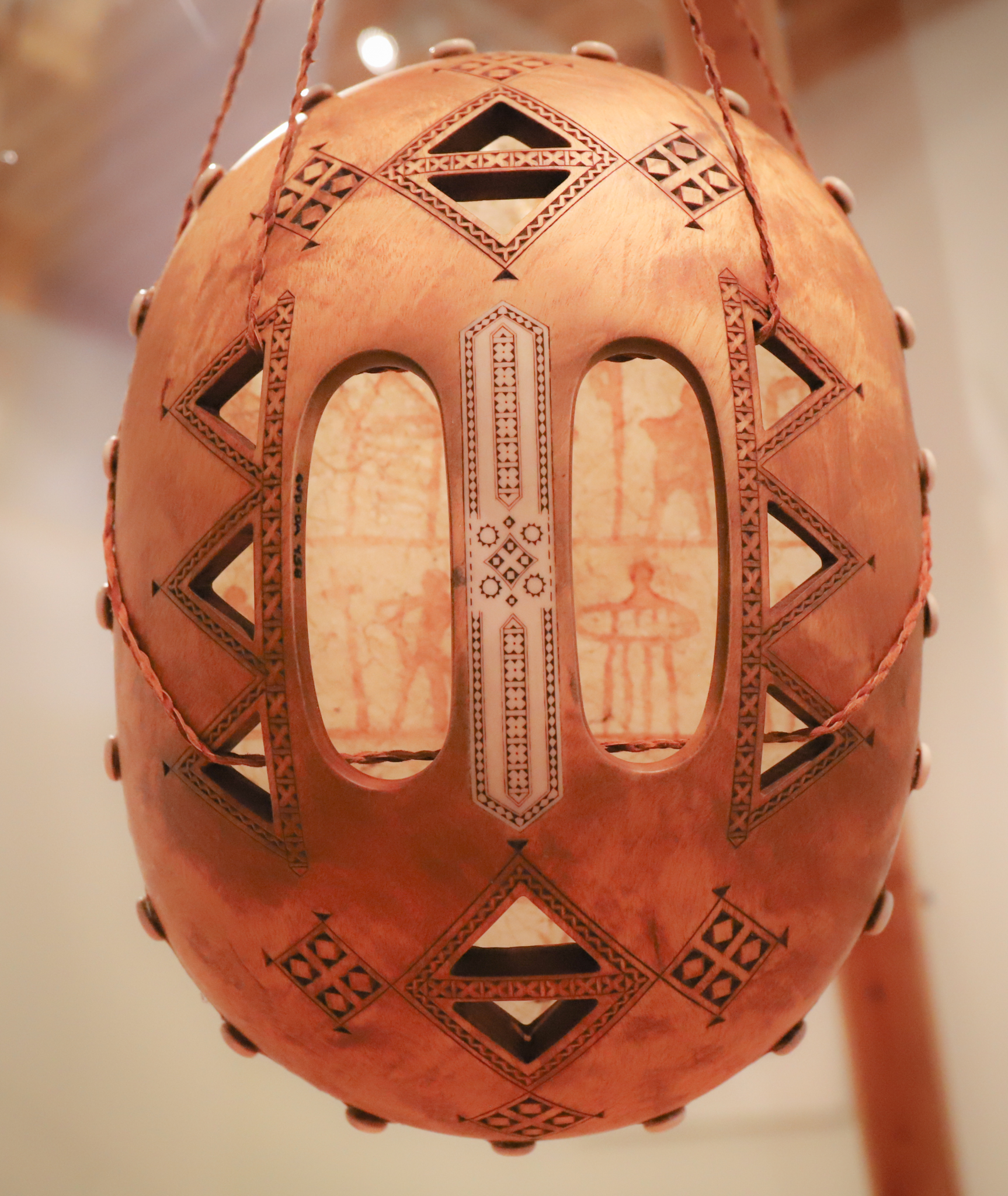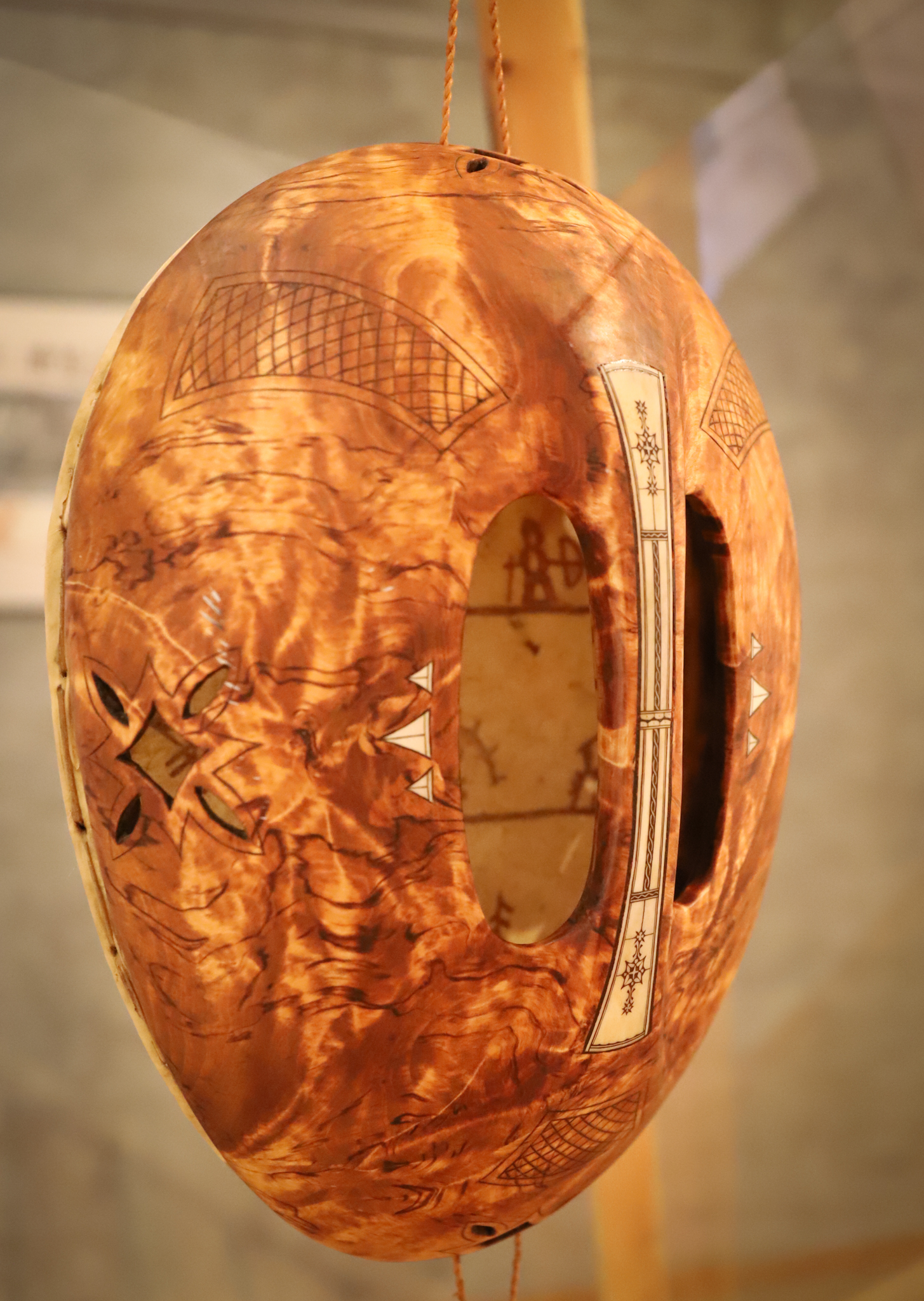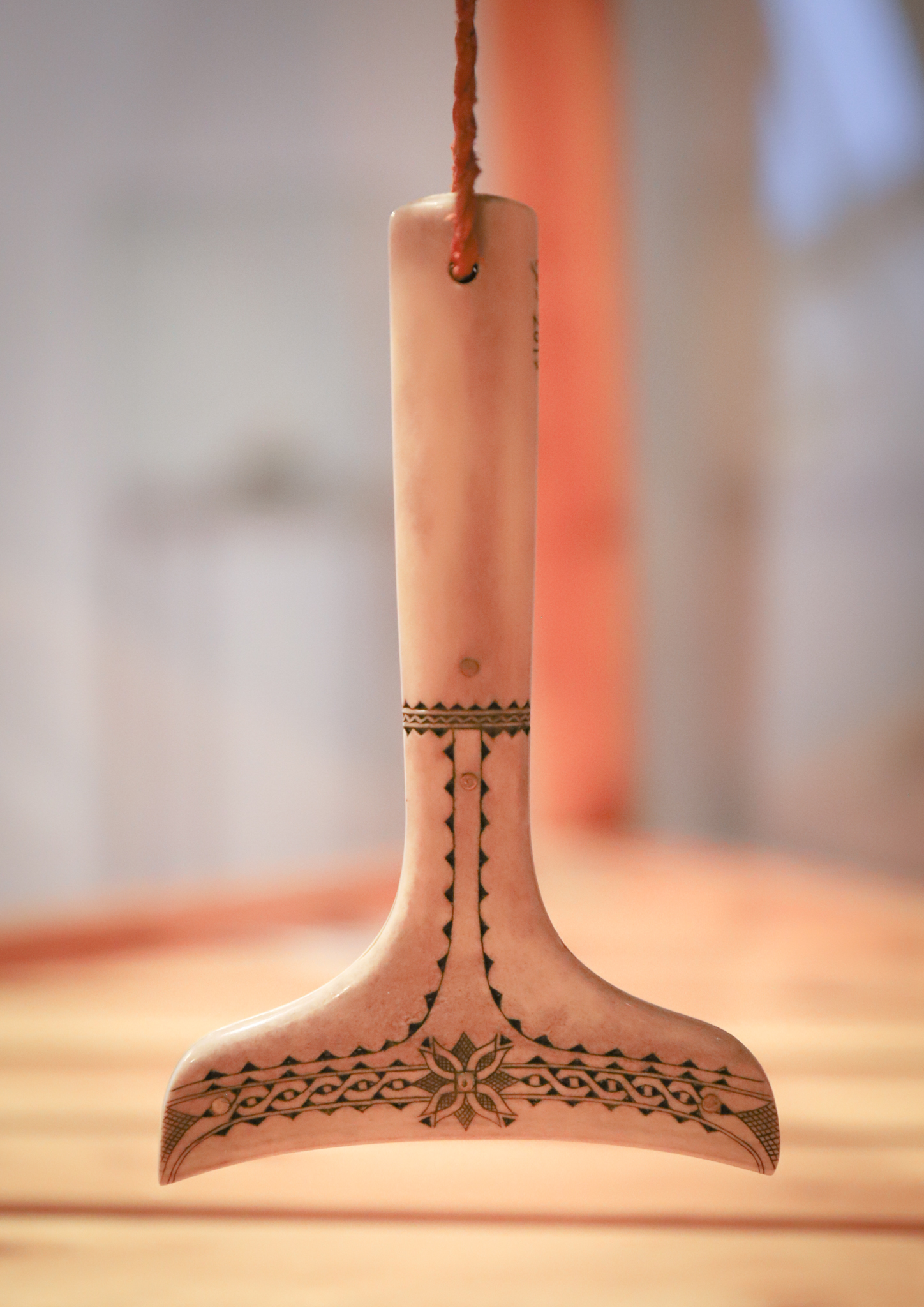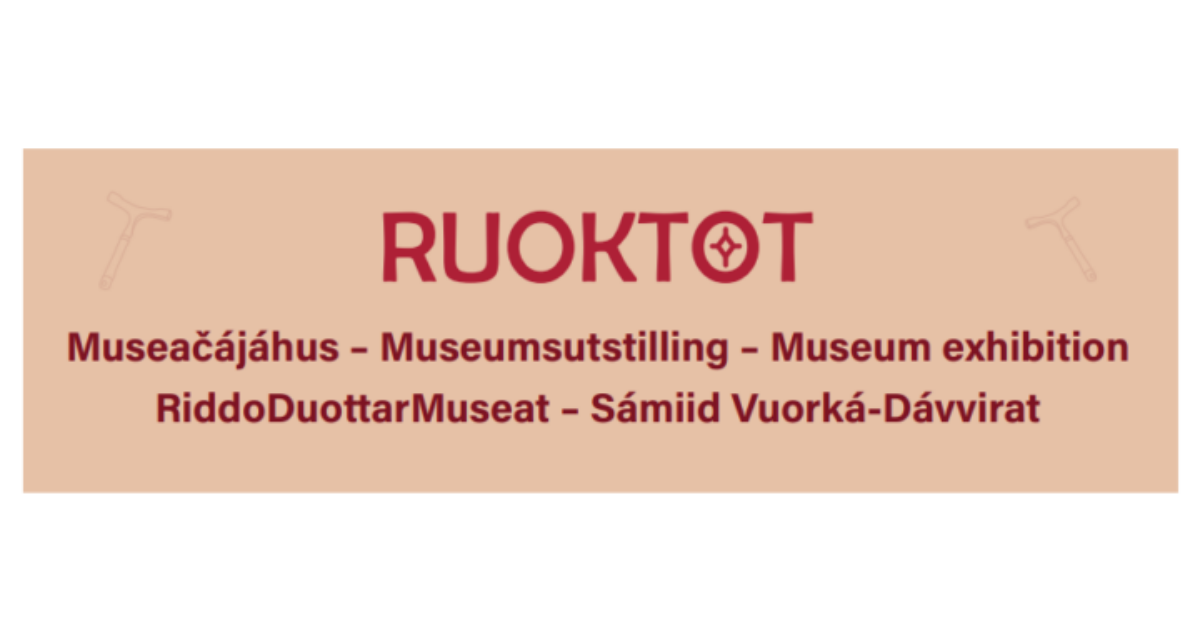
RUOKTOT - The Return of the Sámi Drums is the 50th anniversary exhibition of Sámiid Vuorká-Dávvirat - The Sámi Museum in Karasjok, established in 1972. This travelling exhibition is on display at Nordlansmuseet in Bådåddjo/Bodø, in collaboration with Árran. The exhibition is on display from 08.11.24 until 09.02.25.
The traveling exhibition
The traveling exhibition was first on display at Ájtte in Jåhkåmåhkke/Jokkmokk from 31.01.24. until 18.05.24.
Now you can find the exhibition at Nordlandsmuseet Bådåddjo/Bodø, in collaboration with Árran. The exhibition will be on display there from 08.11.24. until 09.02.25.
In 2025-2026 the exhibition will be on display at Saemien Sijte in Snåase/Snåsa from 17.02.25. until 05.05.25. and at the Siida Sámi Museum in Aanar/Inari from 01.10.25. until 02.04.26.
Our traveling exhibition RUOKTOT is now on display at Bymuseet i Bodø -Nordlandsmuseet. The traveling exhibition has received funding from Nordic Culture Point, who now has published a showcase on their Facebook, Instagram and Linkedin.
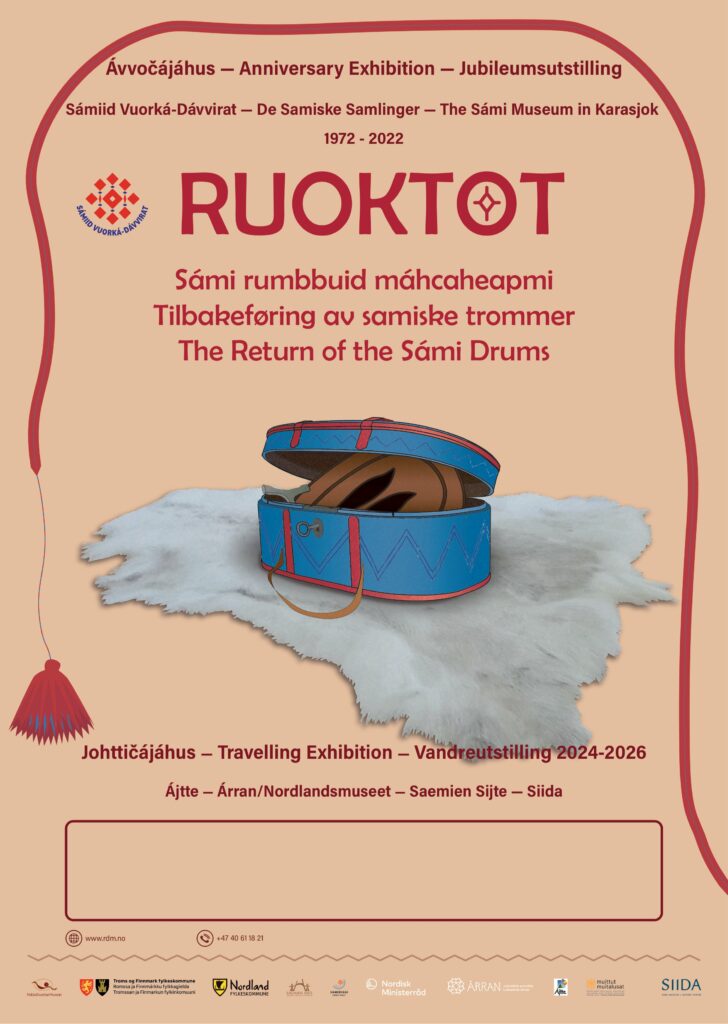
About the Travelling exhibition
Ruoktot in Sámi means going or coming home.
The traveling exhibition is based on the 50th anniversary exhibition that was opened in April 2022 at the RiddoDuottarMuseat (RDM) – Sámiid Vuorká-Dávvirat (SVD) in Kárášjohka (Karasjok). The exhibition focused on the return of the Sámi drums and uses 3D technology. The exhibition celebrated the transfer of ownership over Anders Poulsen’s goavddis (drum), which has been at SVD since 1979. The drum was officially returned from the National Museum in Copenhagen to the RDM-SVD in January 2022. This was good news for everyone who has worked for decades to get the drum back into Sámi care and ownership.
The traveling exhibition is carried out in collaboration between the following Sámi museums: RiddoDuottarMuseat (RDM) – Sámiid Vuorká-Dávvirat (SVD), Ájtte, Árran, Nordlandsmuseet, Saemien Sijte and Siida. The traveling exhibition received financial support from the Sámi Parliament of Norway and from the Nordic Council of Ministers via Nordic Culture Point.
Our original 50th anniversary exhibition is available as a 360° virtual tour: until June 30, 2023!
The link to the 360° virtual tour
See also the News
The exhibition production team
Exhibition concept and curation Jelena Porsanger
Exhibition texts Konsta Kaikkonen, Jelena Porsanger
Exhibition design Jérémie McGowan, Annelise Josefsen
Graphic design Labba Art, Inka Rauhala
Exhibition maps Inka Rauhala
3D models Matthew Walker Magnani
3D-animation, video, videodesign Åsmund Bøe
Drum sound Halvdan Nedrejord, Magnus Vuolab, Skádja Studio
Pictures of 3D models Åsmund Bøe
Artisans – Duojár Osvald Guttorm, Pia Jannok
About the 50th anniversary exhibition
The topic of the 50th anniversary exhibition is “Sámi rumbbuid máhcaheapmi” – The Return of the Sámi Drums. In this exhibition, we use the Sámi term máhcaheapmi in the meaning of repatriation in relation to the return of cultural heritage. According to Sámi oral tradition, a skilful spiritual expert, a noaidi, can possess powers to identify objects that have been stolen or taken away without permission. Furthermore, a noaidi can make those guilty of stealing or taking objects away bring them back to their original owners. Often the drum was used for that purpose.
This process is called máhcahit in North Sámi.
The idea behind the anniversary exhibition came a few years ago, all because of a drum belonging to Anders Poulsen. The National Museum in Denmark owned the 400-year-old drum at that time, which was on loan to SVD from 1979 until recently. The loan agreement would expire by the end of December 2021, but the museum wanted ownership to be transferred from the National Museum in Denmark to RDM-SVD.
The Danish Minister of Culture approved the transfer of ownership of Anders Poulsen’s drum to RDM – Sámiid Vuorká-Dávvirat in January 2022. This is the first time in history that an object of Sámi cultural heritage was returned from abroad to Sápmi. The drum is the main person in the anniversary exhibition.
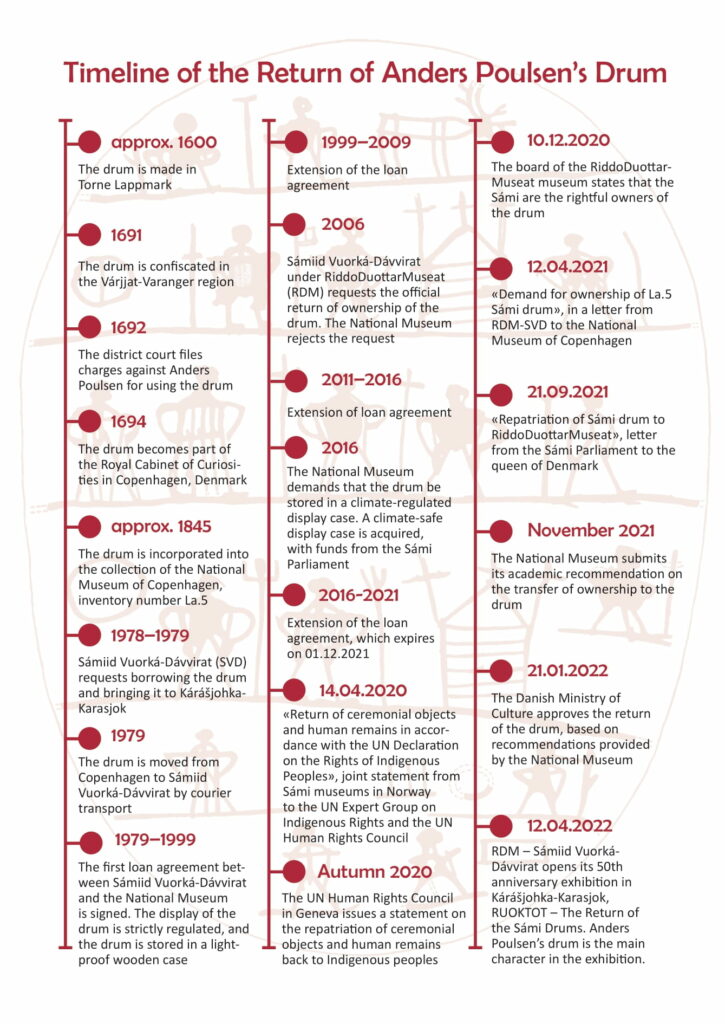
The voiceless time
The meanings and significance of the drums were taken away from Sámi communities when the drums were expropriated during the 17th and 18th centuries and even as late as in the 19th century. Many drums were removed by force. Some were handed to the authorities in fear of corporeal or religious punishment inflicted by representatives of the colonial ruling powers of the kingdoms of Denmark-Norway and Sweden. Most of the sacred Sámi drums were destroyed and burnt, some were lost and some were shipped off, traded or given away as souvenirs.
72 Sámi drums have been preserved and kept in museums and private collections. Recently, several drums or parts of drums have been discovered, hidden away by their owners many hundred years ago. From Sápmi the drums first ended up as exotic objects representing «the Ultimate North» in Stockholm, Uppsala, Trondheim, and Copenhagen, and some of them were taken even further afield to places such as Paris, Rome, London, Cambridge, Berlin, Leipzig, Cologne, Dresden, Munich, etc.
Placed in foreign environments, the drums became voiceless: no one to talk to or with, no language to share, no stories to tell, no one to listen to or to understand them, with no purpose to fill.
Anders Poulsen’s goavddis – drum
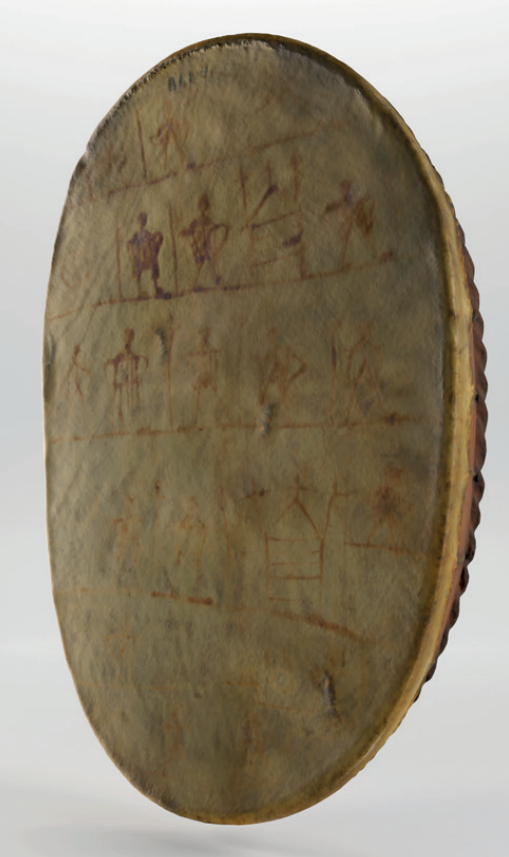
- Ancestry: Davvisápmelaš – North Sámi –
Nordsamisk - Measurements: 44 cm x 33 cm x 10 cm
- Place of origin: The drum and its owner are
originally from Torne Lappmark – Duortnus,
perhaps around Čohkkiras (Jukkasjärvi). - Age: The drum was presumably made before
1650, according to the owner’s testimony. - Embellishments: The wooden part of the drum
is a richly decorated piece of duodji, traditional
Sámi handicraft (garra duodji in Sámi). According
to Anders Poulsen’s testimony, he embellished
the drum with two fox ears, a fox snout, and
claw. Only the fox claw has survived.
-
-
-
-
-
-
-
-
-
-
- The last Sámi owner: Paul-Ánde, Anders
Poulsen, also known as Pávvál Ánde or Poala Ánde,
was born around the year 1600 in Torne
Lappmark. He learned to use the drum from his
mother but he indicated that he initially got the
drum from a Sámi man from Torne Lappmark
named Pedar-Ánde, Anders Pedersen. In 1691 he
was arrested, accused of performing witchcraft,
subsequently imprisoned, and forced to hand
over his drum. In 1692 he was sentenced to
death by the district court in Finnmark, Northern
Norway, in Čáhcesuolu (Vadsø).
- The last Sámi owner: Paul-Ánde, Anders
-
-
-
-
-
-
-
-
-
Ruoktot in Sámi means going or coming home. Three-dimensional images of five Sámi drums make the core of the exhibition. Two of these drums have already returned to Sápmi, the homeland of the Sámi people. Three other drums are still waiting to come home, to be with their people.
The five Sámi drums displayed in the exhibition were selected via a collaboration between Sámiid Vuorká-Dávvirat, Saemien Sijte, Árran, and Siida.We would like to thank all the museums that care for the Sámi drums that were used for the 3D modelling: The Nordic Museum and the State Historical Museum (both in Stockholm, Sweden), GRASSI Museum (Leipzig, Germany), Meiningen Museum (Germany) and, Ájtte (Jokkmokk, Sweden).
Photos from the exhibition, Part 1 “Drums”. Photos: ©RDM-SVD, 2022
- 3D animations and the original drum – Anders Poulsen’s goavddis
- Biographies of the drums
- Goavddis
- The drum hammer belonging to Anders Poulsen’s goavddis
- 3D animation portraying a drum originating from the Torne Lappmark area
- 3D animation portraying the backside of a gievrie, the south sámi drum.
- Storytelling: three stories in South Sámi, Lule Sámi and North Sámi, written by Sámi authors and translated into English and Norwegian. The stories are narrated by professional Sámi actresses and actors.
- The exhibition texts are in three languages: Northern Sámi, English and Norwegian.
- The exhibition texts are based on research and are written from Sámi and Indigenous people’s perspective.
- The maps in the exhibition are based on research, produced by SVD and designed by Inka Rauhala.
- The drum replicas were made in the 1980’s and 1990’s by the local duojár, craftsman Osvald Guttorm.
- A drum replica representing the Kemi Sámi area.
Photos from the exhibition, Part 2 “Drums and Art”. Photos: ©RDM-SVD, 2022
- Drums and dáiddaduodji – contemporary art.
- The drums are displayed in a wooden display case that was designed in 1980’s and 1990’s for a drum exhibition.
- Art by Hans Ragnar Mathisen.
- Art by Hans Ragnar Mathisen.
- «Noaidegárri» by Per Anders, 1992.
- Artwork by Folke Fjäström, 1980.
- A drum by Fredrik Prost.
- Håvard Larsen’s drum (Goavddis), 1992.
- Per Isak Juuso’s “Meavrresgárri”, 2000.
- A closeup of a drum hammer that belongs to Per Isak Juuso.

